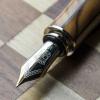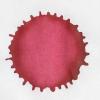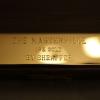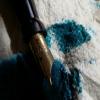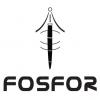Search the Community
Showing results for tags 'disassembly'.
-
With the latest Twsbi Eco making news, I decided to give my old 580 another shot just to make sure whether I should go for another. Find one is good enough for me (personal opinion). Here is also a link to my blog: TWSBI Diamond 580 Review Here goes my review of the 580: My sole motivation behind getting a TWSBI was to disassemble the pen and have all the fun, which I missed. And I got a clear demonstrator, packaged with a nice-looking wrench. THE TWSBI STORY TWSBI (called Twiz-Bee) refers to San Wen Tong, i.e when TWS is spelled backwards and it means ‘Hall of Three Cultures’ according to their website. BI at the end refers to writing instruments. Ta Shin Precision manufactured everything from toy lego parts to high-end writing instruments for several luxury brands (both American & Japanese) for well over 40 years. So that’s plastic, metal & precision, precisely what’s required to make and sell a nice writing instrument, under your own brand name. Which luxury brands? They don’t reveal those due to privacy agreements. I have reasonable doubt from various reviews that one of them is Levenger. And TWSBI Nibs are said to be sourced from JoWo (earlier it was Bock & Schimdt), Germany (same as for Faber-Castell Design Pens). THE FPN CONNECTION An FPN member by the name of speedy started a post with a prototype development for an inexpensive piston filling fountain pen somewhere around late October, 2009. He clarified that he was a pen-maker and shared pictures of TWSBI 530 prototypes in this post. It showed a metallic piston system. And it became a popular brand within a short period of time. http://1.bp.blogspot.com/-aXanzzgVZpc/Vb2tFd_RXXI/AAAAAAAAFAc/VMOIxx7069c/s1600/Prototype.jpg PRESENTATION That’s probably one of the great aspects of marketing. Inside a brown cardboard box, you will find the pen residing within a clear plastic case. You will instantly fall in love with the presentation part of it. For the lack of a better word, I call it The Apple packaging. http://4.bp.blogspot.com/-2v-U9j8mEdg/Vb2r5a2wXVI/AAAAAAAAE_Q/PCrDoboa4xw/s1600/DSC_4802.jpg There is an instruction sheet on disassembly of the pen, highlighting the pen parts. Below the white pen-holding shelf, you will find the 7mm TWSBI wrench and a vial of silicone grease in two slots. http://2.bp.blogspot.com/-1wEqgLBfRVA/Vb2tSxNRwAI/AAAAAAAAFA0/8dvHgT0DmhA/s1600/box.jpg DESIGN - THE GEOMETRICAL TRANSPARENCY (4/6) The build looks sturdy without adding much weight. Plastic economizes both cost and weight of fittings. This pen endorses practical utility rather than art with which you will probably associate a Pelikan or a Visconti. I do find an element of industrial look with the pen. http://4.bp.blogspot.com/-COLWtQyBr-o/Vb2rvkWHSqI/AAAAAAAAE_I/_C5pGu7HVTk/s1600/DSC_4833.jpg Most of it is visible engineering, while use of plastic is quite evident in its piston-system. The barrel and cap are made of thick polycarbonate, with a protective heat treated layer for increased resistance to scratches, along with the crystal transparence. The overall fitment is still an area of improvement. One of my experiences is with the piston knob, which does not tighten itself well, as the piston head is pulled back in. http://2.bp.blogspot.com/-vVlXAJhf34U/Vb2r7Unlx0I/AAAAAAAAE_Y/A6R6VKiUpMQ/s1600/DSC_4829.jpg The cap feels substantial and unscrews with a single turn, revealing a rather dagger-like nib. There is a metallic insert for the nib unit, supplying necessary chrome accents for the aesthetics. The piston knob has a rather broad ring making the mark for disassembly. Multiple polygonal planes orchestrate light effectively within, dazzling both the pen and the ink inside the barrel. The decagonal geometry also prevents an open pen from rolling away. http://1.bp.blogspot.com/-5lnoYSQczHQ/Vb2sO5WHmuI/AAAAAAAAE_w/coWF8V-uyck/s1600/DSC_4837.jpg The cap has a wide chrome band carrying a laser engraved TWSBI on one side of it and DIAMOND 580 TAIWAN on the other, in three separate lines. Two concentric circles run on this band in the form of imprints. The finial carries a vibrant red & silver TWSBI logo of three pillars within a dome of transparent acrylic. The clip is spring-loaded within a visible system having a chrome tassie and it has a geometrical pyramid-like cut. The cap is heavy and has a smooth circular cross section which can roll the entire pen easily with its weight, until the clip restricts it. You can also observe the relatively greyish inner cap, which prevents the nib from drying out. http://4.bp.blogspot.com/-hvFDb1IoLBQ/Vb2tS3yDViI/AAAAAAAAFA4/O1cIkYuxahU/s1600/cap.jpg FILLING SYSTEM (5/6) As a piston filler, it does have a good ink capacity around 1.8~2mL. The knob unscrews with three complete turns and manages to draw ink quite efficiently from the bottle. The feeder hole is rather a channel to enable efficient ink suction. One of the improvements could be with the piston knob, which should increasingly tighten itself, as the piston head is pulled back in. Mine stays loosely fastened (after I applied some silicone grease on the piston head) and is directly proportional to the friction at the piston head. http://3.bp.blogspot.com/-zyu-R2d4OIY/Vb2tEOw3cII/AAAAAAAAFAY/b53TOE9_aQc/s1600/Filler.jpg DISASSEMBLY For this phase, rather than learning from the manual, you can have a look at a 580 disassembly video. I like the one with gouletpens or srebrown. Make sure you thoroughly flush the pen with water before disassembling it. 1. Rotating the piston end-cap counter-clockwise, the piston seal is lowered to a hinged stop inside the barrel. 2. Fit the wrench just below the piston-end-cap, which can unscrewed in a clockwise direction from the piston-knob. http://4.bp.blogspot.com/-NUkTmOyn-1U/Vb2sxi3fPxI/AAAAAAAAFAI/7YzC3qXppfM/s1600/DSC_4903.jpg 3. The piston mechanism has five different parts as you can see in the picture, though it’s not necessary to remove the rubber piston seal (or head) from the piston rod (spindle). The fittings of the mechanism can be made from higher grade material. http://1.bp.blogspot.com/-I1IdSoPmNms/Vb2sps-rsbI/AAAAAAAAFAA/LSsSEwOPHFE/s1600/DSC_4913%2Bcopy.jpg 4. The nib unit can be easily removed by first unscrewing the grip section from the barrel. 5. Since, nib is friction fit, you may remove the nib and feed from the unit, in case there is some heavy cleaning required (in case of a bad flow, sometimes the feed is coated with grease which restricts ink-flow). 6. Make sure you apply an adequate amount of silicone grease to the sides of the rubber piston seal (you may ignore the bottom surface) before reassembly. NIB - ALL THAT MATTERS (4/6) The nib/feed unit can be taken out or apart for cleaning purposes. The nib is stainless steel and has a rather small dagger-like design. It comes with four stock widths - EF, F, M, B and two special widths of Stub 1.1 & Stub 1.5. http://4.bp.blogspot.com/-pUw5Vdlnev4/Vb2sIzRr7-I/AAAAAAAAE_k/h6rOBMIZtfQ/s1600/DSC_4877.jpg The tail end specifies carries the nib width while the name TWSBI along with the logo rest above the tail. There are some curves adorning the inside symmetry of the tines. To be honest it’s kind of a plain design with limited nib leverage. A black plastic feed with a feed channel for ink suction and the thin fins on the other side ensures a good buffer capacity and prevents hard-starts. http://4.bp.blogspot.com/-vdkLuAmZ2NI/Vb2sJai3UzI/AAAAAAAAE_o/fZXFoCmyeW8/s1600/DSC_4893.jpg Earlier, TWSBI used to source its nibs from Schmidt and then Bock, which is incidentally the nib-supplier for Faber-Castell too. But it’s the alloys and then post-processing that can make a lot of difference even in steel-nibs. PHYSICS OF IT (6/6) – RELATIVELY SPEAKING The pen filled with ink, does have a good balance in terms of both weight and length. The pen is not meant to be posted. The grip is quite comfortable with a section around 1 cm thick. Uncapped Length ~ 13 cm Capped Length ~ 14 cm Nib Leverage ~ 2 cm Overall Weight ~ 28 g (Cap Weight ~ 14 g) Capped and uncapped and posted with a pelikan m805 runs below for your reference. A capped 580 looks similar to a m805. http://2.bp.blogspot.com/-NlHUezEy6vA/Vb2soSwhyvI/AAAAAAAAE_4/yewH-68smxg/s1600/DSC_4929.jpg Uncapped it obviously lacks the nib of a m805, although the lengths are well-matched. http://3.bp.blogspot.com/-zIo52iiZJXE/Vb2tCnSS2lI/AAAAAAAAFAQ/0xh7oZmbYUU/s1600/DSC_4937.jpg ECONOMIC VALUE (4/6) It retails at around Rs 5,500 ($ 86) here and I got it from a local store at around $ 70. The problem with ordering it from TWSBI’s website directly is that apart from heavy shipping charges, there are unseen duties to be paid for. Given the fact that you could get one of the usual butter-smooth and more responsive steel-nibbed Faber-Castell pens at a similar or even lesser price, it’s rather a decision of piston vs converter. I hope that the retail prices will get evened out with demand. OVERALL (4.6/6) This nib is wet with a hint of feedback which is expected of fine nibs. I purposely used a less wet ink, since the pen runs smooth with wet inks. There is some line variation which is evident with thicker vertical lines. A complete absence of any perceptible softness in this nib, kills the responsiveness part. The fine nib lays a line which runs between Japanese Fines and European Fines. Being a wet writer out of the box, the Fine nib puts a line which takes around 16-17 seconds to dry on MD Paper with Pelikan 4001 ink. http://2.bp.blogspot.com/-CwXFByod9IE/Vb2tIszp84I/AAAAAAAAFAo/K60KSx721a8/s1600/DSC_4943.jpg INNER CAP - INK RESIDUE In case you find any ink trapped between the inner cap and the cap, a wooden pencil fitted with attached eraser, can help clean it. I have experienced this kind of leakage during air-travel. 1. Take the wooden pencil (Standard #2) and insert the eraser-end into the cap. 2. Bend the cap in one direction, while putting pressure on the eraser in the opposite direction. 3. Slowly use the friction created by the eraser to pull out the inner cap. 4. Wash the ink out (Plain water is fine). 5. Re-insert the inner cap, and screw the pen back in, and it should friction-fit back into its original position. REFERENCES FPN TWSBI Bock Clientele Ink Residue Disassembly - gouletpens, srebrown Thank you for going through the review. You can find some more pen and paraphernalia reviews here.
- 39 replies
-
Heya peeps So my mother recently uncovered her Lamy Safari from when she was much my age (so it's ~20 years old, I'm guessing), and decided to give it to me, knowing that I was into fountain pens. It's a little the worse for wear (or lack of, rather), as she didn't clean it out before it got shelved, containing a goodly quantity of blue sediment. I eventually got the pen apart and (mostly) cleaned up, but the converter is giving a little more resistance. http://i.imgur.com/tNBBwXZ.jpg It's marked as being a Lamy converter, but it's neither a Z24 nor a Z26. The twiddly plastic grip section is circular and ribbed, rather than the semi-rectangular flat of the standard Lamy converters, and the metal divider between the knob and the clear reservoir has etchings at the top of it, all rather different to the Z2* converters. I can't find any mention (or graphical evidence) of these existing anywhere. Anyway, I'm having some difficulty working out how to disassemble it. Regardless of whether it's an authentic, if outdated, Lamy converter, I'd be happy to continue using it if only I could get it apart to give it a good clean. Does anybody have any tips about its origins or how to get the little bugger apart? A few more images.
-
I gave my wife, a lefty, a Sailor Trident for a gift, years ago. She loves it. She's a hook writer, and the Trident's ability to work at a high angle is perfect for her. Except that now she has seen the nano-pigment inks I've been using and wants to use them, for the permanence and because they are so saturated in color. I loaded her Trident up with Montblanc Permanent Blue, which was great for 2-3 weeks, then clogged up in her pen. So I'm going to try De Atramentis Dokument ink -- but I am also now motivated to find a way to take a Trident apart for deep & thorough cleaning. By "deep and thorough," I mean being able to remove the feed and nib from the section -- then you can really get the thing clean. I can unscrew the connector ring from the section -- that is straightforward. But I cannot figure out how to get the exotic Trident nib and feed out of the section. Pushing back on the nib or the surround into which the nib fits doesn't shift anything backwards. The gold collar just behind that, at the front of the section, doesn't seem to unscrew. However, I haven't really pushed or torqued the thing hard, as I don't know what the structure is and don't want to break it. Does anyone have any advice on how to disassemble a Trident? SBRE Brown doesn't have this thing on his disassembly-line set of videos -- you'd think he'd enjoy the sheer challenge of this weird beast. Not even Russ Stutler was able to enlighten me! (To forestall an entire class of responses: I don't need helpful suggestions that I simply avoid using nano-pigment ink in the pen. I am competent to do that on my own -- if I can't work out a way to disassemble and clean it. I'm also currently able to flush the pen with a bulb syringe, and I can always drop the entire nib/feed/section assembly in an ultrasonic cleaner.) E. K.
-
Hello there, I got a little problem with a Pelikan M400 (1980s model). The piston seal has detached from the piston rod and is not sticking in the barrel. Thus, I have to disassemble the M400. Question now: How can I disassemble the piston unit from the barrel? Is that friction fit with the M400 just as it is with the vintage 400? Greetings and Thanx
-
I have two vintage pens by Reform. One is the Astra model (steel nib) and the other is the Rekord 18 model (14k nib). Both are filled using an external piston rod that you screw into the back of the pen (in that respect, like an early prototype of CONID's filling system). The Astra works fine, but the Rekord needs a new cork. And there's my problem: I don't know which end of the pen I should be trying to open. I can't find anything on FPN that might help (only this report from 2014 of a self-destructing model). The section on the Astra can be unscrewed, which speaks for trying the section on the Rekord. That was my first thought. But nothing budges on the Rekord even after application of gentle heat, and I really don't want to break the pen in an uninformed effort to open the wrong end. On the other hand (end) the Rekord has a kind of 'blind cap' and it looks like there are gaps at the end of the barrel for a screwdriver. That makes it tempting to try to unscrew the back - but that could so easily be a recipe for a broken pen. Do you have experience with this model? Do you have any suggestions? Here are two photos that I hope will help. Apologies for the poor quality - I have only my phone camera at present. 1. The barrel (I've pushed the internal mechanism along the barrel to make both ends more visible) 2. Focus on the back
-
Hi there, I have a 244G laying around on my desk and would like to disassemble it. I have thus used the search function but couldn't find a disassembly instruction. Does anyone of you know how to take the 244G apart? Is the feed screwed in or friction fit? Best greetings!
-
I have a Reform Rekord 18 that needs a new cork. I understand it's from the 1940s. Unfortunately, I don't know which end of the pen I should be trying to open and I haven't found anything online that would help. I did post a more detailed request - with pictures - on the Repair Q&A forum, but haven't had any responses. So I'm asking here, too, in case it gets a different audience. Advice gratefully received!
-
Hi all, Having recently begun to use a Pilot Custom Heritage 91 as one of my daily writers, I started to wonder how to go about completely disassembling the pen for cleaning. I have found several disassembly videos for the Custom 74, such as the one by SBREBrown (here), but no comparable videos for the Custom Heritage 91. Since the differences between the Custom 74 and Custom Heritage 91 seem mainly to be cosmetic (flat top and differently-shaped clip, but same nib, feed, and similar-looking section), I was wondering if the Custom Heritage 91 would disassemble in the exact same way that the Custom 74 does. Has anyone owned or fiddled with both these pens and know the answer?
- 4 replies
-
- pilot
- custom heritage 91
-
(and 2 more)
Tagged with:
-
I have a Danish Montblanc 256 G which needs a new cork; but I can't figure out how it comes apart and I don't want to do anything destructive. Has anyone any thoughts? Regards, Craig Retter
-
Hello everybody, as I did not find any related Topic and Workflows from other hero pens don´t work, just one simple question: Does anybody know how to disassemble / remove nib from a Hero 448 for cleaning and moderate adjustment purposes? Thanks for any hint! Best, Tom PS Please: no "if you do not know how to disassemble, you might want to refrain from cleaning/adjustment ideas..." - I see your point, but I have reworked several pens already including repair of leaking Lamy 2000 and successfully reworked Montblancs. I just ask here, because the disassembly of that hero does not look intuitive and before damaging (even a pennies´ fountain pen) I just prefer to ask around some. Any friendly response is more than welcome and I do appreciate!! Thanks in advance and feixang gan xie if someone from the pen´s origin knows how to help...
-
- hero 448
- disassembly
-
(and 1 more)
Tagged with:
-
I am a user rather than a mechanic. I have a 1960s Parker English Duofold (same size as Junior but marked Duofold). I bought it as a user grade pen a while back and it has been fine until ink started leaking from the bottom of the sack. Having done some FPN research,with great care and no difficulty I took it apart and found everything as expected. Until I realized there still seemed to be something in the ink sack and a tatty, thin, plastic rod fell out. This piece is solid, too large to fit in the breather tube, one end appears to have been snipped with pliers and the other looks to have some sort of residue. The pen has clearly been re-sacked at some time (plain black rubber) and my guess is that this plastic rod was used for applying shellac and somehow got left behind (rather like surgeons and scalpels!) I have attached a picture. Can anyone shed any light? Thanks in advance, Martin
- 6 replies
-
- parkeraerometric
- disassembly
-
(and 1 more)
Tagged with:
-
Hey all, I like to disassemble my pens to ensure they are always perfectly clean, and performing the best they can. All my pens can be disassembled easily, and have been, expect my Pelikan M800 nib unit. All until last night... I was flushing it out, and decided I would give it a go, with a nice gentle, but firm pull. Voila! The underside of the nib was pretty dirty, which made me glad that I got it apart. I wiped it with some ''pen flush'' on a cotton swab and it all came off easily. When re-assembling the unit, inside the "collar" there are two very faint lines, which look like where the nib had been. I'm guessing that this ''nib groove'' just develops over time, from the nib being pressed against it constantly, but I when I put it back together, I aligned the nib with it, and it slid in nice and smooth. When sliding the nib onto the feed also, there was a noticeable ''catch'' which aligned the feed perfectly with the nib. Good luck! Tom. Assembled unit The nib Soaking in water Collar and feed
-
Hello everyone! I am somehow stuck in the disassembly of a Salz "Pan Senior" button filler. I am uncertain as to how the nib unit is sitting in the pen section. Is it friction fit or srewed in? Would anyone know? The normal slight hammer bangs on the knock out block did not do the trick as they would normally. Trying to unscrew the nib unit like in a Pelikan did not either, nor did some heat applied. To know for sure which way to go would really make things easier. (I have been very careful with both, heat and also with soaking, because I do not know what material the section is made of.) Can anyone enlighten me either on how the nib unit sits in the section or on the materials? Oh, and by the way, when would this not so common pen have been produced? Thanks, Amelia Edit: Maybe this post should be removed to the repair section? It's just that when I asked for help with a Mentmore over there, I did not receive any answer at all. So I thought, the "specialists" for smaller brands would possibly be found in this part of the forum.
-
- peter pan
- pan senior
-
(and 3 more)
Tagged with:
-
I've tried everything from the hairdryer to warm water to get this pen apart, but it still somehow stays together. So, now I'm pretty sure it's NOT shellac holding it together... could it be glue??? If so, how should I proceed?
- 9 replies
-
- parkersuper 21
- 21
-
(and 2 more)
Tagged with:
-
Hi everyone. I'm trying to replace the nib of my Jinhao 250 with a new nib, the one on my pen leaves a line that is much too thick and wet. I tried removing the nib by two methods: by grabbing on to the bottom of the feed (which is smooth, no fins) and face of the nib as well as by the wings of the nib. Its not budging. If it not meant to come out? Any help would be greatly appreciated as I tried googling it but the 250 does not seem to get a lot of attention in that department.
-

Anybody Know How To Disassemble A Pilot Vortex Section/feed/nib?
Glenn Atkins posted a topic in Japan - Asia
http://www.jetpens.com/Pilot-Vortex-Fountain-Pen-Fine-Nib-Clear-Green/pd/10539 Thanks in advance for help, tips, or ideas.... Glenn- 2 replies
-
- pilot vortex
- disassembly
-
(and 3 more)
Tagged with:
-
So, I'm an idiot... (Scroll to bottom for the short version) After a trip to my relatives overseas, I was kindly gifted with two 146s. They were in pretty bad shape though and had a ton of dried ink inside. So, when I came back from my holidays, I gave them a good clean. Then, after a little reading and videos on YouTube, it was apparent that the nib and feed of the 146 can be removed without any tools as they are friction fit. So, my curious side had me pull out the nib and feed on one of the 146 which came out with a lot less force than I expected. After I cleaned out the feed, I tried to put it back into the section. Error #1) I forgot to take note of how the nib and feed were positioned in the section. So, I just looked at the other 146 and decided that the nib is horizontal with the two slots/holes in the section. It should be noted that these two pens are definitely from different production years. The pen in question has a six digit serial and is marked W-GERMANY, has "No 146" on the cap band and the ink window is not striped. The other 146 has a 2 letter, 6 number serial, is marked GERMANY, is missing "No 146" and has a striped ink window. The feeds themselves also look different. At first it felt a little tight, but I'm assuming that is pretty normal, as I've pulled out nibs and feeds on other pens before (albeit much cheaper pens). The nib and feed did not make it far: http://i.imgur.com/VveKKPH.jpg Hmm.. Initially, I tried to force the feed in, but that just seems like a bad idea, so after a couple of tries, I scrapped that plan. I'm pretty sure the best thing would be to get the nib and feed out and to try again. Easier said than done. Using my hands, I think I'm apply way more force than what I should be. I tried using the grippy, rubbery mats to aid in traction, but that didn't really help. Plus, this was about when I started to notice that I was bending the fins in the feed. So I tried using the grippy mat with pliers. Doesn't seem very safe... Even that didn't work (I used the plier to grab onto the tip of the nib to avoid squishing the feed into a million pieces). I even tried warm water and some Singer Machine Oil to try and lubricate it. That didn't help. So after a little Googlin', I found that the nib and feed unit could be taken out of the grip section with special tools. Improvising, I just twisted the nib and feed gently, with started to unscrew the unit out of the pen. However, this didn't get me anywhere. I noticed, and removed, the so-called "Montblanc Gum" which I've heard may be used by MB to check if anyone has been tampering with the pen. http://i.imgur.com/bDsBMTA.jpg So, I need the help FPN to help me. So, how do I remove the nib and feed from the pen (without damaging the nib and feed obviously)? And, if I can't do anything, will Montblanc service be able to help? <-- Not very confident in this as a) I did remove the nib and feed and I managed to unscrew the unit holding it in place and got rid of the "Montblanc gum". tl;dr Nib and feed stuck in 146. How do I get it out?
-
Does anyone have experience with the disassembly of a Lamy Studio? I understand from other threads that it should be similar to a Lamy Safari - grab the feed and pull it out - but I don't manage to get it to move. I tried to pull it out, using rubber gloves to have good grip, but no luck. I also tried to push it out by pressing it down on a plastic tube, nothing. Is there a lever that I have to press down or so? Any suggestions will be appreciated!
- 2 replies
-
- lamy studio
- disassembly
-
(and 1 more)
Tagged with:
-
Hello! I've been recently given a Visconti D'essai by a friend and although it was solt to him as a NOS, the piston seems to be jammed (or perhaps the rod is broken?). Turning he piston knob seems to do something inside because it can only turn so far on one dirrection or another,but the piston stays put at the middle of the barrel. Now,the problem is that I have no ideea how to disassemble the pen and I was hoping that someone around here knows. I've tried soaking the whole pen (with the nib and feed pulled out) in water with dish washing detergent, but to no effect. I also tried to push on the piston from the section side but I didn't dare push it to strongly and it didn't budge. As far as the disassembly goes, the piston knob has no retaining pin (as in an Aurora 88k or a Luxor Grand Visible) or any sort of grooves or flat sides for a sort of key to be fitted and then pulled apart (as with the 149 or m1000...) also I tried heating the section to try and pull it out as in the old fountin pens and still nothing. So as you can see I'm struggling with this mint beautiful example that simply doesn t work. Please leave any suggestions especially if you have disassembled simmilar piston fillers. Thank you!
-
I made a tool using delrin rod on my lathe to disassemble the Pilot VP nib unit. I was amazed to see the intricate engineering that has gone into making it. Especially the feed which is a two parts feed as you can see in the picture below. http://farm8.staticflickr.com/7424/8720366749_9d8eba03c6.jpg Anyways, the reason for me to do this, was to see how I can fix the feed itself. As you can see in the next picture, the feed has a slight bent which causes it to create a gap between the nib. This affects the ink flow. I believe this is caused due to longer periods of storage. The pen I have is one of the early versions of VP with the faceted body. http://farm8.staticflickr.com/7304/8721490718_322101031a.jpg I am not sure how to solve the feed problem. Please suggest any ideas. Thank you.

